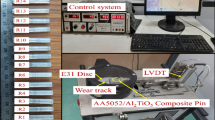Composite materials based on polymers provide the necessary complex of physical and mechanical properties, wear resistance, as well as high repairability due to multiple renewals of component's surfaces by composites that are used as coatings. Based on the conducted trials, a model was built, and the analysis of the parameters of epoxy composite coatings with disperse fillers of different nature, oxides and carbides, based on the physical and geometrical properties of spherical external surface layers and their impact on residual stresses in epoxy composite coatings, was performed. The graphical models were built, and the residual stress dependencies from the parameters of the components of epoxy composite coatings with disperse fillers of different nature were obtained, based on the physical and geometrical properties of the external surface layers. The diagrams for the oxides and carbides fillers are obtained, using the results of samplings and calculations of the mass content of the filler and the diagrams of external surface layers mass per composite volume unit. The recommendations for the optimal coating formation are established based on the minimization of the material residual stresses. The composite parameter ranges, which are not recommended to use, are indicated.



Similar content being viewed by others
References
A. V. Buketov, N. A. Dolgov, A. A. Sapronov, and V. D. Nigalatii, “Adhesive pull and shear strength of epoxy nanocomposite coatings filled with ultradispersed diamond,” Strength Mater., 50, No. 3, 425–431 (2018), https://doi.org/10.1007/s11223-018-9986-5.
N. A. Dolgov, N. N. Buketova, A. V. Besov, “Comparison of different methods for determining residual stresses in polymer coatings,” Vost.-Evrop. Zh. Peredov. Tekhnol., 3, No. 7, 40–42 (2012).
V. I. Pokhmurskii, V. B. Dalisov, and V. M. Golubets, Increasing the Durability of Machine Parts with Diffusion Coatings [in Russian], Naukova Dumka, Kiev (1980).
E. B. Trostyanskaya (Ed.), Engineering Plastics (Reactoplasts) [in Russian], Khimiya, Moscow (1974).
A. V. Buketov, N. A. Dolgov, A. A. Sapronov, et al., “Mechanical characteristics of epoxy nanocomposite coatings with ultradisperse diamond particles,” Strength Mater., 49, No. 3, 464–471 (2017), https://doi.org/10.1007/s11223-017-9888-y.
Y. Z. Chen and X. Y. Lin, “Collinear Zener–Stroh crack problem in plane elasticity,” Eng. Fract. Mech., 75, No. 6, 1684–1693 (2008).
T. Kakiuchi, T. Shioya, and K. Fujimoto, “Analysis of anti-plane crack in finite thickness plate,” J. Solid Mech. Mater. Eng., 1, No. 4, 584–591 (2007).
I. B. Prokopovych and L. M. Senkiv, “Stressed state of anisotropic cylindrical shells with cuts”, in: Advances in Fracture Resistance in Materials (Proc. of the 8th Int. Congr. on Fracture, Vol. 1, McGraw-Hill, New Delhi (1996), pp. 547–552.
V. Chekurin and L. Postolaki, “Problem of non-destructive determination of residual stresses in a pipeline by magneto-elastic measurements,” in: Physical and Mathematical Modeling and Information Technologies [in Ukrainian], Vol. 20, Lviv (2014), pp. 218–228.
J. Weertman, Dislocation Based Fracture Mechanics, World Scientific Publishing Company (1996).
X. J. Wu, “A continuosly distributed model of Zener–Stroh–Koehler cracks in anisotropic materials,” Int. J. Solids Struct., 42, No. 7, 1909–1921 (2005).
Th. Nitschke-Pagel and K. Dilger, “Characterization of residual stresses and hardness condition in welded joints using micromagnetic parameters,” in: Proc. of the Nineteenth Int. Offshore and Polar Engineering Conf. (June 21–26, 2009, Osaka, Japan), ISOPE (2009), pp. 332–337.
E. Rusinski, J. Szmochowsks, and T. Smolnicki, Zaawansowana Metoda Elementov Skonczonych w Konstrukcjach Nosnych, Oficyna Wydawnicza Politechniiki Wroclawskiej, Wroclaw, Poland (2000).
I. Dobrotvor and D. Stuhlyak, “Investigation of residual stresses in epoxy composite coatings for different dispersed fillers,” Visn. KhNU, Ser. Tekhn. Nauky, No. 4, 86–93 (2018).
P. Stukhlyak and K. Moroz, “Influence of porosity in in the epoxy matrix polyvinyl alcohol disperse filler system on the impact toughness,” Mater. Sci., 46, No. 4, 455–463 (2011).
V. V. Klyuev (Ed.), Nondestructive Testing: Handbook [in Russian], Mashinostroenie, Moscow (2004).
I. Dobrotvor, P. Stuhlyak, A. Mykytyhyn, and M. Mytnyk, Analysis of Pattern Recognition Systems of Composites Structure [in Ukrainian], Ivan Puluj TSTU, Ternopil (2018).
D. Zahorodnia, Y. Pigovsky, P. Bykovyy, et al., “Structural statistic method identifying facial images by contour characteristic points,” in: 2015 IEEE 8th Int. Conf. on Intelligent Data Acquisition and Advanced Computing Systems: Technology and Applications (IDAACS) (2015), pp. 293–297, https://doi.org/10.1109/IDAACS.2015.7340746.
O. Dunets, C. Wolff, A. Sachenko, et al., “Multi-agent system of IT project planning,” in: 2017 IEEE 9th Int. Conf. on Intelligent Data Acquisition and Advanced Computing Systems: Technology and Applications (IDAACS) (2017), pp. 548–552, https://doi.org/10.1109/IDAACS.2017.8095141.
P. Stukhljak, I. Dobrotvor, M. Mytnyk, and A. Mykytyshyn, “Investigation of the phenomena revealed on phase interface in epoxide-composites,” Przetworstwo Tworzyw, 23, No. 1 (175), 53–63 (2017).
P. Stukhlyak, M. Mytnyk, and V. Orlov, “Influence of boundary interlayers on properties of composite polymeric materials (a review),” Mater. Sci., 37, No. 1, 80–86 (2001).
P. Stuhlyak, I. Dobrotvor, M. Mytnyk, and O. Yastubchak, “Technology of protective coatings based on estimates of the characteristics of structures of epoxy composites,” Visn. TNTU, No. 3 (75), 114–121 (2014).
Author information
Authors and Affiliations
Corresponding author
Additional information
Translated from Problemy Prochnosti, No. 2, pp. 88 – 95, March – April, 2021.
Rights and permissions
About this article
Cite this article
Dobrotvor, I.G., Stukhlyak, P.D., Mykytyshyn, A.G. et al. Influence of Thickness and Dispersed Impurities on Residual Stresses in Epoxy Composite Coatings. Strength Mater 53, 283–290 (2021). https://doi.org/10.1007/s11223-021-00287-x
Received:
Published:
Issue Date:
DOI: https://doi.org/10.1007/s11223-021-00287-x




